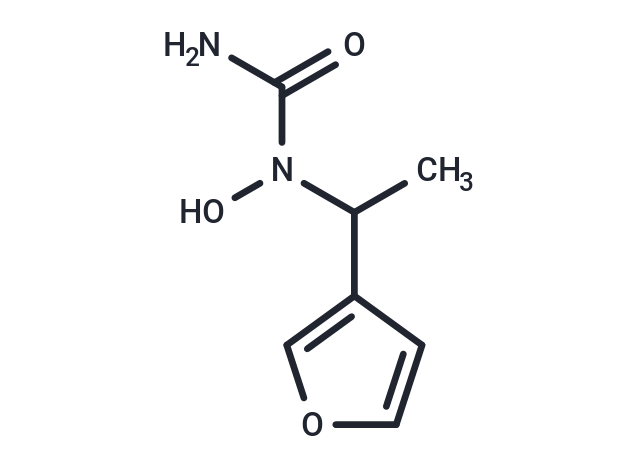Shopping Cart
- Remove All
 Your shopping cart is currently empty
Your shopping cart is currently empty

A-69412 (N-1-(Fur-3-ylethyl)-N-hydroxyurea) is a reversible, specific inhibitor of the hydrophilic 5-lipoxygenase. It has the potential to treat ulcerative colitis and asthma, and possibly other inflammatory and allergic conditions.

| Pack Size | Price | Availability | Quantity |
|---|---|---|---|
| 1 mg | $117 | In Stock | |
| 5 mg | $269 | In Stock | |
| 10 mg | $395 | In Stock | |
| 25 mg | $592 | In Stock | |
| 50 mg | $834 | In Stock | |
| 100 mg | $1,120 | In Stock | |
| 500 mg | $2,260 | In Stock | |
| 1 mL x 10 mM (in DMSO) | $198 | In Stock |
| Description | A-69412 (N-1-(Fur-3-ylethyl)-N-hydroxyurea) is a reversible, specific inhibitor of the hydrophilic 5-lipoxygenase. It has the potential to treat ulcerative colitis and asthma, and possibly other inflammatory and allergic conditions. |
| Targets&IC50 | 5-LOX:1 μM, LTB4:1 μM |
| In vitro | A-69412 inhibits the formation of 5-HETE by the 20000×g supernatant of RBL-I cells in a dose-dependent manner. Additionally, A-69412 inhibits LTB4 formation in calcium ionophore A23187-stimulated human PMNL (IC50=8.9 μM) and is significantly more potent in inhibiting LTB4 formation in ionophore-stimulated human whole blood. Across various assays using multiple donors, A-69412 consistently shows activity in the low micromolar range (mean IC50=1.4 μM, range 0.5-3 μM, 9 donors), demonstrating several-fold greater potency compared to other in vitro assays[1]. |
| In vivo | Oral administration of A-69412 effectively inhibits leukotriene production across various species, demonstrating its potent, long-acting nature. In rats, A-69412 exhibits strong inhibition of leukotriene formation with an oral effective dose (ED50) of 5 mg/kg. Similarly, in dogs, a single dose of 5 mg/kg ensures nearly complete leukotriene inhibition for up to 16 hours, with plasma concentrations measuring 38 μM at 0.5 hours post-dose and reducing to 5 μM at 16 hours. These results align with ex vivo observations of 100% inhibition at 0.5 hours and 90% at 16 hours post-dosing. Moreover, A-69412 outperforms zileuton in cynomolgus monkeys, maintaining over 50% inhibition of LTB4 biosynthesis for 8 hours compared to zileuton's effectiveness within just the first 2 hours post-dosing. In rat models of anaphylactic reaction, oral A-69412 dose-dependently curbs leukotriene production in the peritoneal cavity, with blood levels ranging between 4 to 100 μM for doses of 2 to 50 mg/kg. Remarkably, A-69412 continues to significantly inhibit leukotriene production when administered up to 8 hours before the antigen challenge, with plasma concentrations ranging from 44 μM at 0.5 hours to 10 μM at 8 hours post-dosing[1]. |
| Animal Research | A-69412 is suspended in 0.2% methylcellulose with a Potter-Elvehjem homogenizer equipped with a Teflon-coated pestle and administered orally (20 mg/kg) to beagle dogs, cynomolgus monkeys, and male SD rats. Zileuton is used for comparison. All animals are fasted overnight before dosing but allowed water ad libitum. Heparinized blood samples are obtained before and at various times after compound administration in the dog and monkey studies. Groups of rats are dosed with vehicle or A-69412 and 1 h and 15 min later, the animals are sacrificed and blood collected by cardiac puncture into heparinized syringes. Aliquots of blood from all the three species are incubated at 37°C with 50 μM calcium ionophore, A23187. After 30min, the blood is placed in an ice bath and analyzed for LTB4. |
| Alias | N-1-(Fur-3-ylethyl)-N-hydroxyurea |
| Molecular Weight | 170.17 |
| Formula | C7H10N2O3 |
| Cas No. | 123606-23-5 |
| Smiles | C(N(C(N)=O)O)(C)C=1C=COC1 |
| Relative Density. | 1.33g/cm3 |
| Storage | Powder: -20°C for 3 years | In solvent: -80°C for 1 year | Shipping with blue ice. | |||||||||||||||||||||||||||||||||||
| Solubility Information | DMSO: 45 mg/mL (264.44 mM), Sonication is recommended. | |||||||||||||||||||||||||||||||||||
Solution Preparation Table | ||||||||||||||||||||||||||||||||||||
DMSO
| ||||||||||||||||||||||||||||||||||||

Copyright © 2015-2025 TargetMol Chemicals Inc. All Rights Reserved.